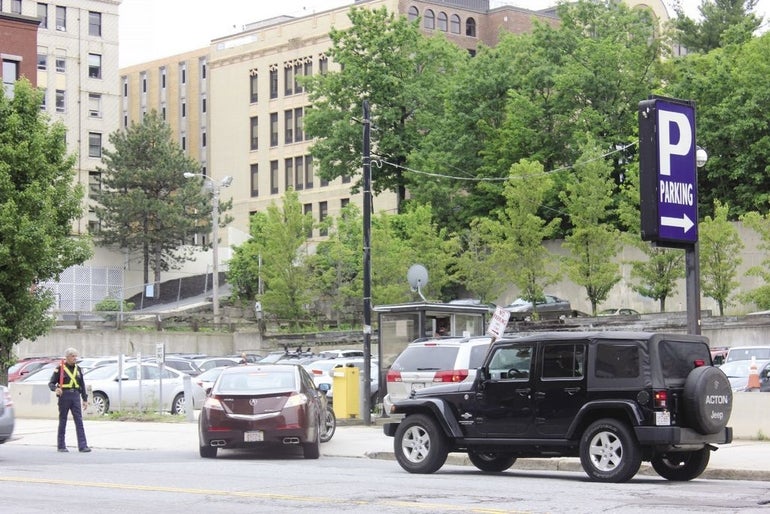In a not-so-distant future, a freshly minted college graduate from WPI has just landed her first real job, at a life sciences company in Marlborough. She chooses to remain in Worcester, moving into one of the roughly 800 residential units recently completed in or around the city’s downtown. She doesn’t mind the commute to Marlborough, but, in general, driving is the farthest thing from her mind as she decides whether to walk to Armsby Abbey for dinner, bike to Ralph’s for a beer with friends or, hop on the bus and check out the Ecotarium on the weekend.
This hypothetical young professional is among the tenants developers are targeting and Worcester officials and business leaders are attempting to accommodate through expanded transportation options in the city as Worcester continues to grow.
“It’s something we think about as we build that density downtown and market to young professionals, millennials and college students: ‘How do we make it easier for people to go back and forth?’” Worcester Regional Chamber of Commerce President Tim Murray said.
“Providing as many options as possible that aren’t car-reliant is part of it in that comprehensive strategy, and biking and walking and signage are all pieces of that.”
While American transportation infrastructure has largely favored the automobile over the last 50 years, growing the downtown — and the entire city — requires a comprehensive approach that includes automobiles, walking, biking and public transit, according to Stephen Rolle, the city’s planning director.
“It’s really the recognition that streets aren’t facilities whose only objective is to move cars.
That’s how the profession in general designed them for years,” he said. “The focus now really is on building roads to be flexible and accommodating in the way that can support the broadest range of groups possible.”
‘Complete’ and safer streets
This concept has come to be known as “complete streets.” Worcester has “decent bones” to incorporate complete streets, with much of the city built with large sidewalks and roadways that accommodate biking, said Karin Valentine Goins, co-chair of Walk Bike Worcester, which advocates for safe biking and walking. Building up alternative transportation involves addressing the safety — such as at major intersections — and the attractiveness of biking or walking through the addition of trees, benches and businesses on major thoroughfares, she said.
Rolle said Worcester is moving in that direction with upcoming projects, such as the Main Street improvements that will run south from Belmont and Highland streets to beyond Chandler Street. While construction is scheduled to begin next year, it’s important to keep a global perspective on how the city is tied together, he said.
“That is a great example of the kind of street that needs to work well for a variety of users,” Rolle said. “It needs to be a multifunctional street. It needs to be attractive and support businesses.”
Creating a walkable city will ultimately help boost business, Goins said. That will get people out of their cars and boosting foot traffic.
Businesses are an integral part of making the city more walkable, Murray added.
“As we build density downtown, we are trying to build street-level retail so people can get out of their cars and walk and have a set of experiences,” he said. “We are trying to time this so that, as they come online, there are desirable retail (establishments), whether it be prepared food or retail shops.”
Biking will also be a part of building businesses and connecting residents with the rest of the city, said Murray. Locating part of the Longsjo Classic bicycle race, which pits riders against each other on city streets, is one step that has been taken to emphasize biking.
“Part of the reason we wanted it in Worcester and the downtown is to reinforce that we are bike-friendly, and that is one of the modes of transportation we need to be talking about,” Murray said. “Bike paths need to be constructed.”
Those bike paths could connect disparate parts of the city, and potentially hook students on its benefits, he said.
But all that takes time, Rolle said. For instance, creating a network of bike paths or improving lighting along sidewalks must be tackled project by project.
Adding to parking inventory
In the meantime, parking is not being neglected, he said. There are 500 spots that will come online with the completion of the City Square project, and the current municipal lots spread throughout the city are not at capacity, and are not expected to be any time soon.
Murray contends that parking can be an issue for downtown businesses. To stave off the potential for tighter parking, the chamber is exploring the potential for a new garage near the Hanover Theatre for the Performing Arts and how to optimize the use of current garages and lots.
Street parking is a major issue, said Bill Aldrich, chef and owner of the Theatre Café. With downtown spaces at a premium between those living close by and working downtown, it can deter people from driving into the area.
“It is a problem drawing people … downtown in the evening for sure,” Aldrich said, explaining that some patrons use Worcester Regional Transit Authority buses and bike to the restaurant. “We do see a lot of foot traffic during the day from the local businesses … (but) public parking would help, as would a complete slowdown” of downtown-area traffic.
Aldrich would like to see the speed limit lowered and speed bumps installed, while helping make the area friendlier to other forms of transportation.
Regardless of whether by car, bus, bike or foot, easy transportation will be key in capitalizing on the new developments in and around downtown, Murray said.
“Transportation is economic development and economic development relies on transportation,” he said. “So by incorporating as many modes that are functional and reliable, then you are going to boost economic facilities.”

